Problem Chosen
F
2020
MCM/ICM
Summary Sheet
Team Control Number
2005623
The Wandering Homeland
Summary
Global warming has caused the rising of sea level, making the seawater flooded the land,
leaving some people homeless and becoming Environmentally Displaced Person (EDP). How-
ever, there is not a single unified policy for solving the EDP problem in the world. As the sea
level continues to rise, the land area of small island countries and some coastal countries is
decreasing, and the EDP problem is becoming increasingly urgent.
We analyse the Issue Paper and find the main problems in EDPs’ survival and cultural
protection. To address these problems, we propose a policy named ’the Wandering Homeland
Policy’.
According to the sea level rising data in recent years, with the land area and altitude data
from 4 countries, we use geometric knowledge to build a cone model to predict the annual
growth of EDP in Small Island Developing States (SIDS) over the next 50 years. Taking only
small island developing countries into consideration, there will be 18,230,968 EDPs worldwide
in the next 50 years to come. Then, we use Greenhouse Gas emission (GG), GDP per capita,
Arable Land per capita (AL), and Renewable Freshwater Resources (RFR) per capita as factors
to determine the receiving country and the receiving share. After that, we use the Entropy
Weight Method (EWM) to obtain the weights of these four indicators by Matlab, which is
[0.259 0.239 0.139 0.363], and get its scores of 50 countries. Then we identify 20 countries that
receive EDP and redistribute their proportion of recipients.
Based on the Lotka-Volterra Model, we build a competing model between local cultures
and foreign cultures, mapping the relationship between local and foreign cultures over time
and illustrate the need to implement a protection policy for EDPs’ culture.
We establish a model to estimate the economic impact of EDP on the receiving countries,
integrating the forecast data of EDP in the next 50 years, obtaining the income curve of each
receiving country in the next 50 years, and analysing the income and expenditure of countries
with different economic conditions. The results show that our policy is brilliant for the eco-
nomic development of developed countries, but not good for some of the developing countries.
Moreover, we analyse the results of our model and evaluate it objectively to help us im-
prove our policy. Combining with the actual situation, we explain the necessity and strengths
of implement our policy.
At the end of our paper, we make sensitivity analysis, the result of which proves that
our model has a good stability.
Keywords: Sea level rising, EDP, Policies, EWM, Lotka-Volterra Model.
�
Contents
1
Introduction
1.1 Literature Review .
. . . . . . . . . . . . . . . . . . . . . . . . . . . .
1.2 Restatement of the Tasks . . . . . . . . . . . . . . . . . . . . . . . . . . . .
.
.
.
2 Analysis of the Issue Paper
2.1 The survival of the EDPs at risk . . . . . . . . . . . . . . . . . . . . . . . .
2.2 The risk of losing the EDPs’ own culture heritage . . . . . . . . . . . . . .
3 The ’Wandering Homeland Policy’ on EDPs given by our team
3.1 Assumptions for the ’Wandering Homeland Policy’
3.2 The statement of ’Wandering Homeland Policy’
. . . . . . . . . . . .
. . . . . . . . . . . . . .
4 Notations
5 The Models
5.1 Model 1: The number of EDPs by Geometry math . . . . . . . . . . . . .
5.2 Model 2: The distribution of EDPs of principal responsible countries
using the Entropy Weight Method . . . . . . . . . . . . . . . . . . . . . .
5.2.1 Our primary indicator system . . . . . . . . . . . . . . . . . . . . .
5.2.2 Calculate weights of each country by EWM . . . . . . . . . . . . .
5.3 Model 3: The competing model between foreign culture native cultures
by the Lotka-Volterra model . . . . . . . . . . . . . . . . . . . . . . . . . .
. . . . . . . . . . . . . . . . . .
5.4 Model 4: The model of Economic Impact
5.5 Results of the Economic Benefit of EDPs in 20 received countries . . . . .
6 The Improvements and Weaknesses in our policies
7 The Importance and Strengths of implementing our policies
8 Sensitivity Analysis
9 Conclusion
References
1
1
1
2
2
3
4
4
4
5
6
6
8
8
9
10
12
13
15
17
18
18
20
�
Team # 2005623
1
Introduction
1.1 Literature Review
Page 1 of 21
Nowadays, many researchers have done researches which bring the miserable situ-
ation that the global environment has been facing during the past decades to us human
beings, who emphasize that the ecological system will be worse inevitably if we main-
tain our living behavior.
The word Environmentally Displaced Persons (EDP) is used to describe some peo-
ple whose homeland becomes uninhabitable due to some environmental stressors, for
example, the climate change[1]; or describe groups of persons who, for compelling rea-
sons of sudden or progressive changes in the environment that adversely affect their
lives or living conditions, are obliged to leave their habitual homes either temporarily
or permanently, and who move either within their country or abroad[2].
There are many researchers identifying some of the island nations being in the dan-
ger of sea levels rising. It is better for the EDPs to relocate their address to safer places
since their homeland is at the risk of being drowned by the ocean. However, there are
still many problems they will meet in future, such as being discriminated as refugees,
losing their own culture heritage, facing with difficulties in being received by groups
from different circumstances, and so on.
Fortunately, the United Nations High Commission on Refugees (UNHCR) has dis-
covered the dilemma the EDPs may meet. In a recent ruling during the last several
years[3], UNHCR has acknowledged that some of the EDPs can be recognized as
refugees. There are also many scholars who make presentations to a number of inter-
national policymaking fora, helping to raise the profile of these issues and to shape in-
ternational responses[4]. With receiving many assistance from politicians and scholars
all over the world, we are full of confidence that the problem of EDPs will be brought
to a satisfactory settlement in the upcoming years.
1.2 Restatement of the Tasks
In order to clarify our tasks, we simplify our team’s 5 tasks below:
Task 1 Analyze the scope of the Issue Paper from some necessary prospectives, such
as the number of people at risk, the risk of loss of EDPs’ own culture, and so
on.
Task 2 Give our team’s Proposed Policies, which address EDPs in terms of both hu-
man rights and cultural preservation.
Task 3 Develop Models to measure the potential impact of our proposed policies.
Task 4 Explain how our models work or improve our proposed policies.
Task 5 Demonstrate the importance of implementing our proposed policies backed by
our analysis in Task 1.
�
Team # 2005623
Page 2 of 21
2 Analysis of the Issue Paper
Since there are so many political problems appeared in the Issue Paper, our team
has analyzed the scope of the issue from the following prospectives to help us solving
the tough problems.
Figure 1: The mindmap of our issue analysis
2.1 The survival of the EDPs at risk
• Climate change has made damaged to the safety of EDPs. Due to the rapid
development of industry, most of the industrialized countries emit large amounts
of carbon emission in the form of CO2, making the greenhouse effect worse. At
the same time, the periodic changes of sea surface temperature lead to global
warming, which melts the sea ice and raises the sea levels, causing the land in
some areas being in salinization or flooded. This tragic event makes the land
unable to produce food, even losing the capability of dwelling for human, which
is the reason for these EDPs why they have to migrate to another place. Based
on this, we think that carbon emissions are an important factor in measuring the
amount of EDPs received by a country.
Figure 2: Heights above sea level vary across cities. Source[5]: IPCC, NASA, Realclimate.org,
NewScientist.com, Potsdam institute, Sea Level Explorer.
�
Team # 2005623
Page 3 of 21
• The conditions of the receiving country may not meet the basic survival re-
quirements of the EDPs. As a human being, an EDP has his or her own basic
survival needs, for example, getting enough food to sustain his or her life. The
carrying capacity of human beings in an environment is the maximum popu-
lation size that the environment can sustain indefinitely, given the food, habi-
tat, water, and other necessities available in the environment using the local or
other resources and intellectual and technical conditions[6]. When considering
the number of EDPs a country can receive, not only do we need to consider its
carbon emissions to determine how much responsibility it should take for its EDP
receiving country, but also need to think of its carrying capacity.
• It is necessary to make plans for the migration process of the EDPs on a time
scale. Depending on the different geography of each country, the scope of the
effects of sea-level rising and other environmental stresses is in connection with
the time. For example, the situation of EDPs is often not formed in a short time,
but gradually formed in the face of continuous climate changes. Therefore, it is
necessary to make some plans on the time scale to avoid or minimize the loss of
the countries (e.g. the problem of the EDPs) caused by climate change.
2.2 The risk of losing the EDPs’ own culture heritage
• Different types of cultural heritage may suffer different levels of losses. Cul-
tural heritage includes tangible culture, intangible culture (e.g. folklore, tradi-
tions, language, and knowledge) and natural heritage (including culturally sig-
nificant landscapes, and biodiversity), and the tangible cultural heritage is gener-
ally split into two groups of movable (e.g.books, documents, moveable artworks,
machines and clothing) and immovable heritage (e.g. historical buildings, monu-
ments, landscapes and artifacts)[7]. In the process of the sea level rise, the loss of
these categories of cultural heritage is obviously different, due to their inherent
property.
• We endeavor to protect the cultural heritage of the EDPs under the premise of
ensuring to house the EDPs. Since the cultural heritage is the precious wealth
of human civilization, our human beings are obliged to preserve that the culture
will not be lost by migration. Just like the menu costs in economic principles.
If a manufacturer changes the price of their products, he needs to inform his
customers of the new price and give a suitable reason for this change. All this
incurs a new cost. If the EDPs migrate to a new place, they need to spend a cost
to settle down, learn to adapt to the new environment and new social norms.
In conclusion, we need to carefully consider various factors to make a decision
where the EDPs will immigrate.
• The EDPs has spiritual needs besides living requirements. As they come from
their own country, they have basic cultural demands, such as preserving or in-
herit their previous culture and religious beliefs, living a normal life in the new
society without discrimination. As a result, it is significant to consider and assess
the social stability, cultural diversity and nationalist orientation of the received
country, which may lead to some injury to the EDPs.
�
Team # 2005623
Page 4 of 21
3 The ’Wandering Homeland Policy’ on EDPs given by
our team
Based on the analysis above, affected by the climate change, the EDP is at risk in
terms of personal safety and culture protection. For one thing, the EDPs face great
danger of sea level rising and the shortage of the existence needs. For another, they
may lost their spiritual requirement in the foreign land where their culture may not
appear. Therefore, our team decides to propose our policies to help the EDPs from all
over the world to have a more comfortable life, which is called ’Wandering Homeland
Policy’.
3.1 Assumptions for the ’Wandering Homeland Policy’
• Our policies are only suitable for the EDPs whose homeland is destroyed by the
sea-level rising. Refugees triggered by other elements of climate or meteological
disaster, such as the hurricane, flood, and earthquake, are not in consideration
for these policies.
• Assumed that all the EDPs, including potential ones, all agree to immigrate. Since
the sea-level rising has threatened their safety, they all agree to relocate to make
ends meet.
• Supposed that the global political situation will remain stable for a considerable
period of time. The countries that is now without war will remain the situation
in the upcoming years.
3.2 The statement of ’Wandering Homeland Policy’
i) Each country has an obligation to give assistance to the EDPs. Greenhouse ef-
fects and the carbon emission made by all human beings are the major cause of the
rising of sea levels, which threaten the personal safety of EDPs. As we are obliged
to build a community of shared future for mankind, people all around the world
should take their own responsibilities.
ii) The main type of assistance to EDPs from each country is Direct assistance (DA).
The receiving country should be responsible for the financial contributions of
EDPs.
iii) Arrange the responsibilities of each country. The list of these indicators are de-
termined: the greenhouse gas emission (GG), the GDP per capita, the arable land
per capita (AL) and the renewable freshwater resources per capita (RF R). With
the datum in the past decades, we can arrange the responsible percentage of each
country on the problem of EDPs.
iv) For environmentally forced refugees, based on "non-refoulement obligations" in
international human rights law, the receiving countries have an obligation to
protect environmental refugees who have migrated to their countries. As the
�
Team # 2005623
Page 5 of 21
original places of residence of the EDPs has been lost, the receiving countries can-
not repatriate the EDP and can only develop appropriate policies to help the EDPs
settle or obtain citizenships in that country.
v) Cultural classification for EDPs: (1) Material culture: Material culture that can
be relocated, material culture that cannot be relocated; (2) Intangible culture: Lan-
guage, skills, customs, religions, etc. (Consider the culture carried by EDPs)
vi) The relocatable material culture shall be resolved through consultations between
the EDPs’ local governments, UNESCO and donations, museum collections, and
auctions shall be conducted to ensure that these material cultures are properly
kept.
vii) For the non-removable material culture, measures such as data collection, tech-
nical protection and remote reproduction shall be carried out by the EDPs local
governments and UNESCO.
viii) Receiving countries should implement an open and inclusive protective policy to
protect the culture of EDPs when it receives EDPs.
4 Notations
The primary notations used in this paper are listed in Table 1.
Symbol
EDP
UNHCR
h0
R0
h
r
∆h
ρ0
γ
t
v
NEDP(t)
GG
AL
RFR
Table 1: Notations
Abbreviation
Environmentally Displaced Person
the United Nations High Commission on Refugees
the original height of the cone Island nations
The original base radius of our hypothetical cone
The altitude of a point on the cone
The latest base radius of the cone affected by the rise of sea level
Change in the sea level
the population density of those island nations
the growth rate of population of those island nations
the time of model evolution
The velocity of sea level rising
The number of EDPs in the year t
Greenhouse gas emission
Arable land per capita
Renewable freshwater resources per capita
�
Team # 2005623
5 The Models
Page 6 of 21
5.1 Model 1: The number of EDPs by Geometry math
As most of the small islands are from developing states with small size, high popu-
lation density, finite funds and weak resistance to natural disasters, we regard them as
the source of EDPs.
For one thing, some researchers have found that the sea level rises linearly, which
is 3.44 mm per year.
Figure 3: The original sea level data and its linear fitting. Data source: [8]
We can express the relationship between time and the change of sea level as below.
∆h = vt
(1)
where
• ∆h represents the height change in sea level.
• v represents the velocity of the sea level rising, which is 3.44 mm per year.
• t represents the time.
For another, there will be around 65 million people in 2070, who are living in de-
veloping island nations, where the population density ρ is 444 person per square kilo-
meter, and the growth rate γ is 2.3% now[9]. Since almost all the island nations consist
mainly of a number of island chains, they have a low altitude, and the highest natural
point are lower than 10 meters. In conclusion, we use the four countries given by the
problem as representatives, which are The Maldives, Tuvalu, Kiribati, and The Mar-
shall Islands and are all facing the difficulty of losing their homeland due to the sea
level rising. The total amount of population of the four countries is 584,408, and the
total area is 1,316 square kilometers.
We decide to approximate these four island nations as a regular cone island, as the
figure below. The new cone island has a base area of 444 square kilometers, a base
radium R0 of 20 kilometers, and an origin altitude h0 of 2 meters.
�

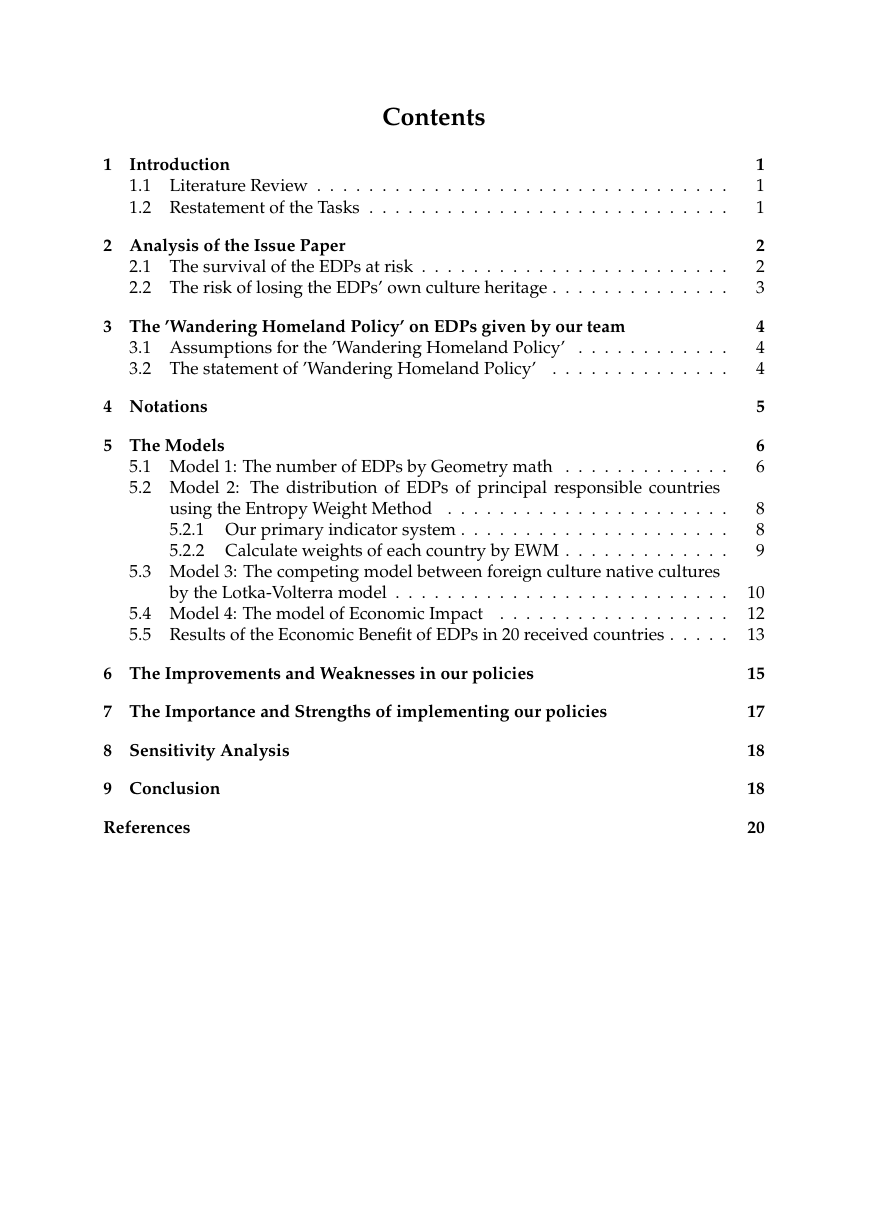


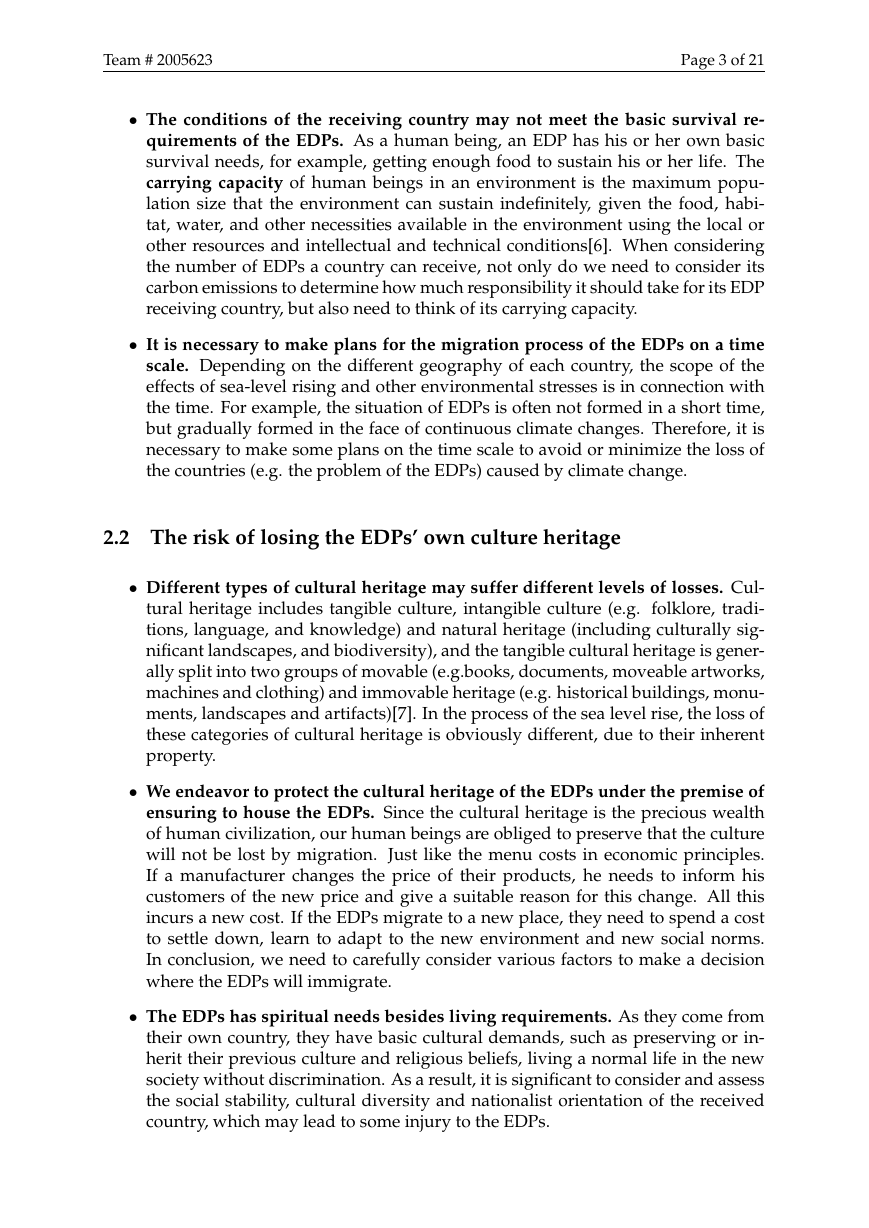
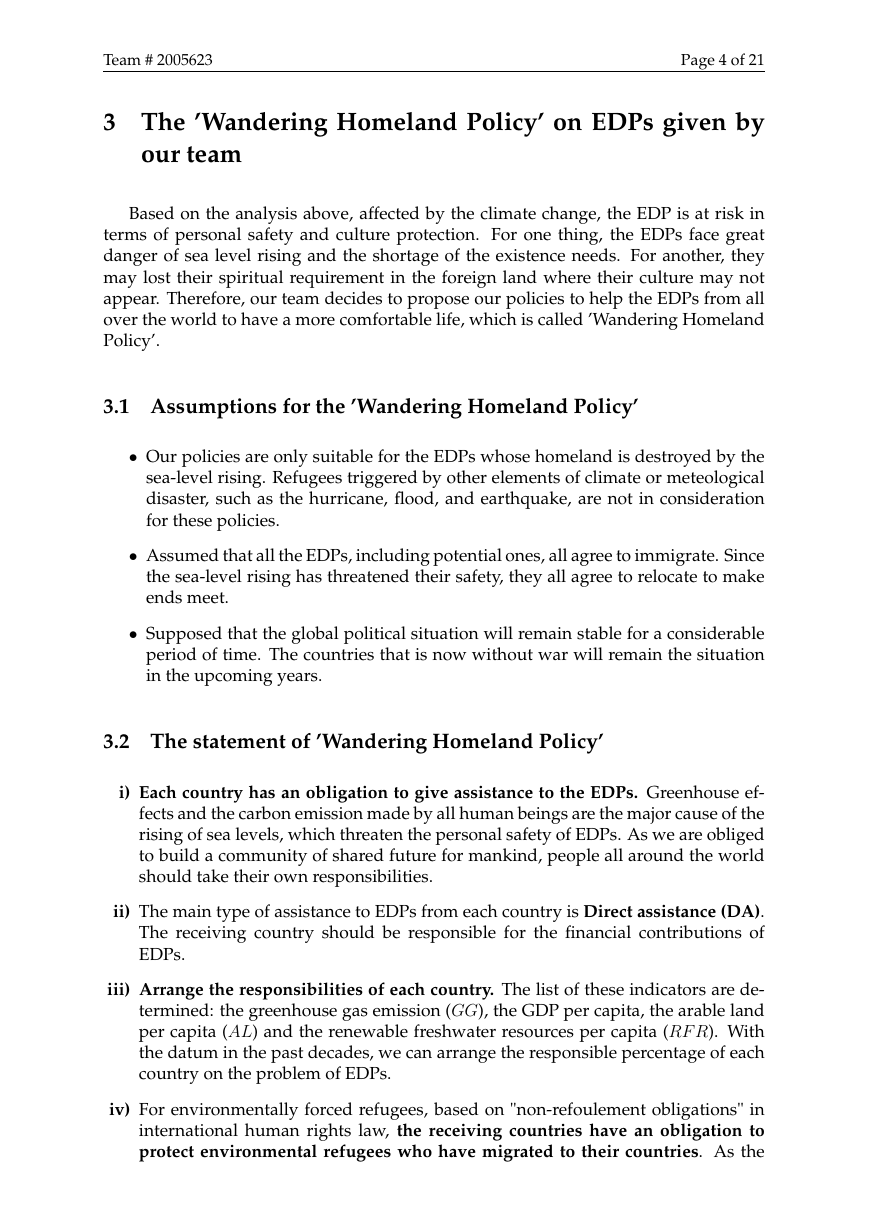
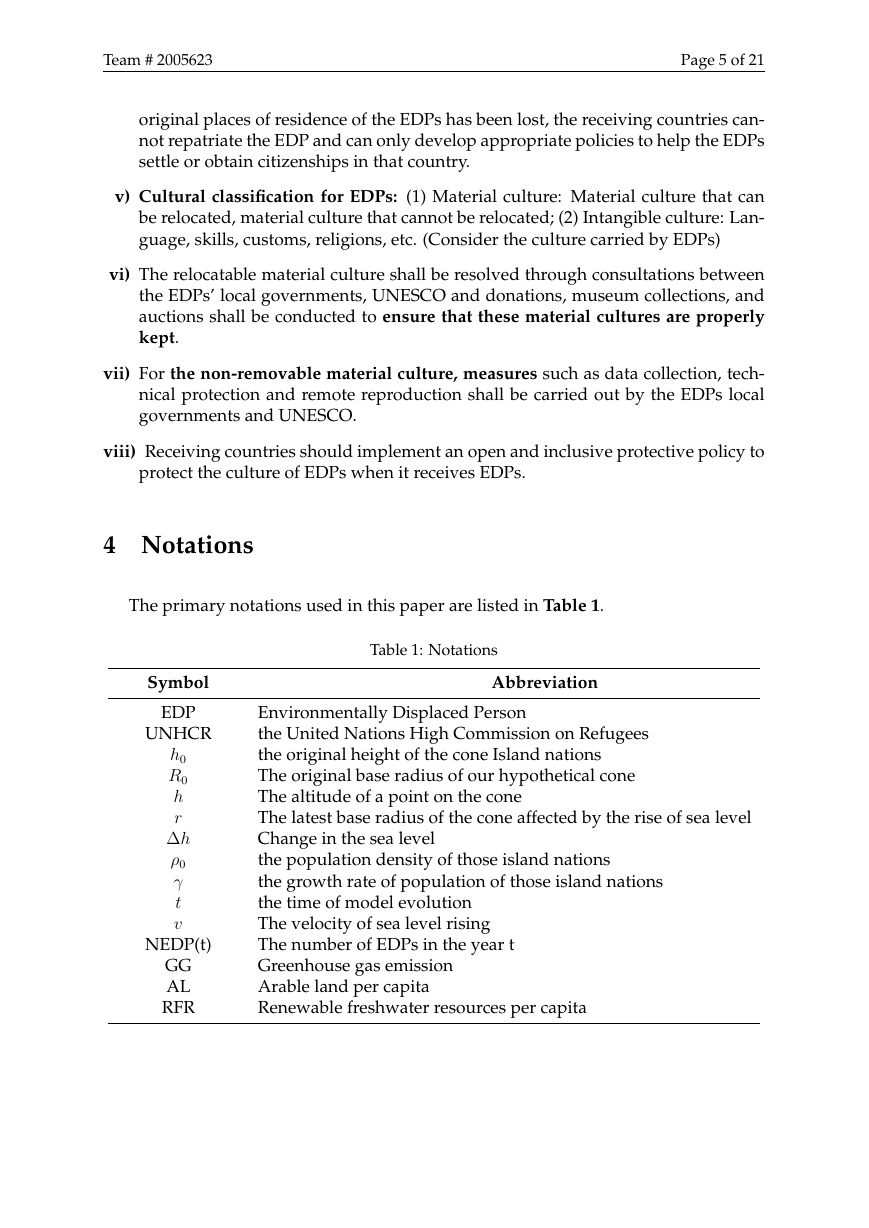
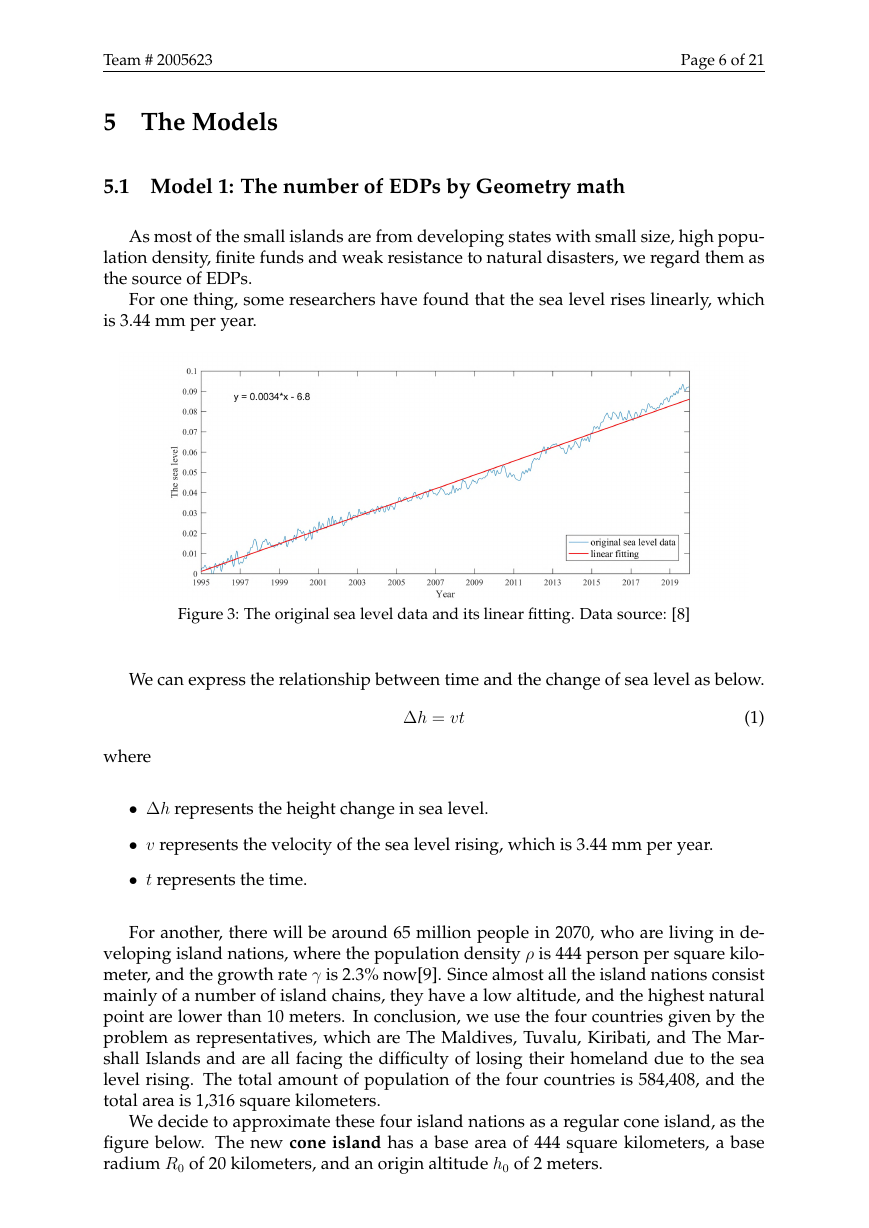








 2023年江西萍乡中考道德与法治真题及答案.doc
2023年江西萍乡中考道德与法治真题及答案.doc 2012年重庆南川中考生物真题及答案.doc
2012年重庆南川中考生物真题及答案.doc 2013年江西师范大学地理学综合及文艺理论基础考研真题.doc
2013年江西师范大学地理学综合及文艺理论基础考研真题.doc 2020年四川甘孜小升初语文真题及答案I卷.doc
2020年四川甘孜小升初语文真题及答案I卷.doc 2020年注册岩土工程师专业基础考试真题及答案.doc
2020年注册岩土工程师专业基础考试真题及答案.doc 2023-2024学年福建省厦门市九年级上学期数学月考试题及答案.doc
2023-2024学年福建省厦门市九年级上学期数学月考试题及答案.doc 2021-2022学年辽宁省沈阳市大东区九年级上学期语文期末试题及答案.doc
2021-2022学年辽宁省沈阳市大东区九年级上学期语文期末试题及答案.doc 2022-2023学年北京东城区初三第一学期物理期末试卷及答案.doc
2022-2023学年北京东城区初三第一学期物理期末试卷及答案.doc 2018上半年江西教师资格初中地理学科知识与教学能力真题及答案.doc
2018上半年江西教师资格初中地理学科知识与教学能力真题及答案.doc 2012年河北国家公务员申论考试真题及答案-省级.doc
2012年河北国家公务员申论考试真题及答案-省级.doc 2020-2021学年江苏省扬州市江都区邵樊片九年级上学期数学第一次质量检测试题及答案.doc
2020-2021学年江苏省扬州市江都区邵樊片九年级上学期数学第一次质量检测试题及答案.doc 2022下半年黑龙江教师资格证中学综合素质真题及答案.doc
2022下半年黑龙江教师资格证中学综合素质真题及答案.doc